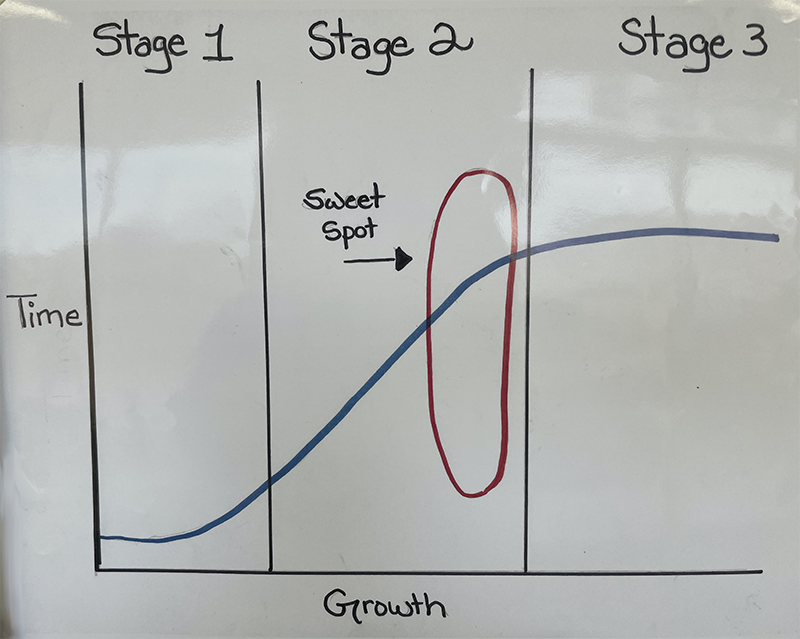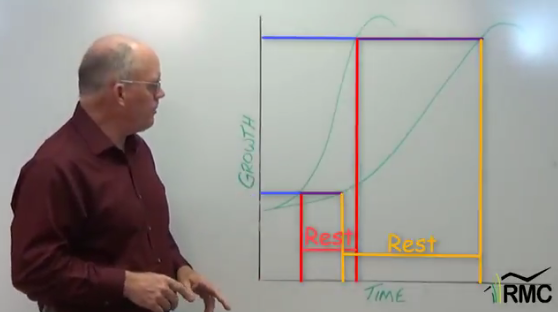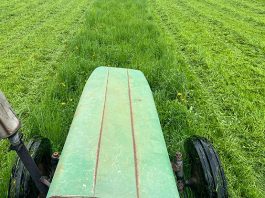
Grazing in the Sweet Spot is a phrase I have been using for over a decade. Until the last few years I have only used that term when talking to myself. I didn’t have a good handle on how to explain it to others. Now that I have thought about it for a number of years, I feel I am ready. That explanation is what this article is about.
Let me first explain why I graze in the sweet spot. First off, grazing in this zone is the fastest growth of the sward. If we keep the sward in the sweet spot we will realize much better forage production than grazing on either side of the sweet spot. The more forage we produce the more animals we can graze or the longer we can graze them.
Another benefit of grazing in the sweet spot is increased animal performance. Forage at this stage is neither too mature nor too washy for animals to experience good gains. It is common to realize 50-80lbs increased weaning weights on calves when they have been grazing in that zone all summer. The years I have grazed sheep I have sold 115lbs lambs that are only 4 ½ months old when grazing in the sweet spot.

Grazing the sweet spot is also how I consistently have high quality, high volume, stockpiled forage. When you have high quality, high volume stockpiled forage the economic benefit is huge. Every day you graze instead of feeding your animals is money that stays in your pocket. If you are a custom grazier every day you can keep the herd means more money that goes into your pocket. (Here’s more on my stockpiling technique.)
What is the Sweet Spot?
To answer that question, you must first understand the growth curve of plants.
There are three major phases of grass growth. The first stage is characterized by slow, highly palatable growth. This is the first growth in Spring. Stage Two grass grows rapidly thanks to increased leaf area (solar panel) and is also very nutritious. Another name for this is “Boot Stage.” Stage Three is the reproductive period. Grass grows slowly, is setting seed, and is less nutritious. The Sweet Spot is in late Stage Two growth just before going into Stage Three.
Here’s a link to an article and video to help you figure out what stage your grasses are in.
Know Your Grass Growth Stages for Successful Grazing Management
However, there is a caveat; the Sweet Spot relates to the sward as a whole and not individual plants. Since species of plants have different life cycles and grow at different rates, it is next to impossible to graze at a time when all plants are in late Stage Two. Some species like timothy and smooth brome get into Stage Three very rapidly. That means when you are grazing in the sweet spot the sward will have some plants in the reproductive phase. It does not mean all plants will be in Stage Three.
Here’s how I determine the stage of growth for the sward. When I walk through a paddock, I don’t pay attention to the timothy or smooth brome – those grasses that mature most quickly. Instead, I look at the other forages. Are the other forages starting to flower or get into the boot stage? If 10-15% of the other forages are in the boot stage, then for me that means the sward is in the sweet spot.
Of course, I could be wrong. so I use another indicator to check my judgment. Animal dung tells me if I’m grazing where I want to be.
Animal dung changes depending on the protein content and dry matter the animal is eating. The higher the protein content, the wetter the manure. For cattle this means a cow pat that is 2” high. If the pat is closer to 4-5” then you know you are grazing in Stage Three. If there is not really any pat, but more like lava, then you know you are too early and the sward needs more time to recover.

Want more manure? Here’s a great article by Jim Gerrish describing what good and bad manure pats look like.
With sheep dung, you know you are in the sweet spot when it is mushy and not pellets. The only time I have seen sheep with lava dung is when they are sick. (What is lava dung and is it important to include reference to it here?) When grazing horses, you will be in the sweet spot when the dung resembles a cow pat that stands 4-5” high. If the dung is splashy, you are grazing too early. (Dodging splashy horse dung can be a real hazard when driving a carriage – just saying!)
Grazing in the sweet spot is like a triple threat. You benefit by increased animal performance, improved forage production, and you benefit economically. I have been grazing in the sweet spot for over 10 years and each year it warms the cockles of my heart to see the improvement in these three areas of the grass I manage. I know there are other philosophies of grazing, but based on my experience, grazing the sweet spot consistently shines in dry years, wet years, and all the years in between.




